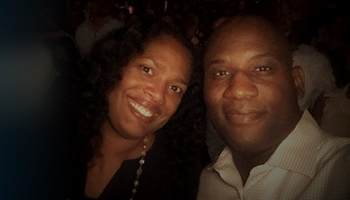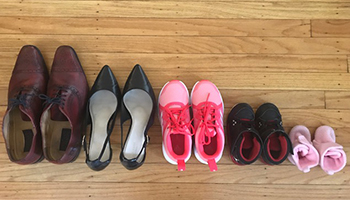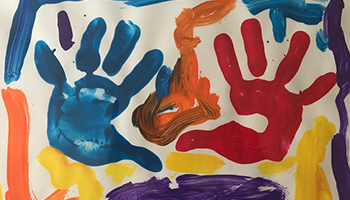HOW CAN WE HELP YOU? Call 1-800-TRY-CHOP
In This Section
Providing a Happy Home for Foster Children

Paulette McRae, PhD, and husband, Terrence, provide a safe and loving space for three foster children.
mccannn [at] email.chop.edu (By Nancy McCann)
Editor’s Note: Our seasonal “Off Campus” series on Cornerstone is back. Last summer, we shared fun stories and photos about our colleagues and what they do to de-stress and reset. Get to know your colleagues — even if you’re working remotely! Learn who among us is an avid skier, tango dancer, bird watcher, baker, and more. These easy-to-read stories help us connect with each other in new ways and build community, particularly now during the coronavirus pandemic. If you know of someone with an unusual hobby or interest in your department or lab, the Research Creative Services writers want to hear from you. Or nominate yourself! Send us an researchcomm [at] email.chop.edu (email). Maybe you’ll be our next “Off Campus” celebrity.
Paulette McRae, PhD, enhances and supports Children’s Hospital of Philadelphia’s growing population of diverse scientists. As assistant director of Special Programs and Diversity in the Office of Academic Training and Outreach Programs (ATOP), she develops relevant programming and creates an inclusive and welcoming environment for researchers from all backgrounds. Her off campus hours are no different, as she creates an inclusive and welcoming environment for foster children in her home.
As a scientist by training, Dr. McRae and her entrepreneurial husband, Terrence, went into foster parenting with their eyes wide open — they did their research. Choosing a foster agency is like choosing a college, Dr. McRae said; it needs to be the right fit.
“We did what analytical people do. We started asking questions, reaching out to different agencies, getting connected with current foster parents and talking with them about their journey,” Dr. McRae said. “As we got deeper into the process of understanding what fostering was all about, and what would be asked and required of us, we felt we would be able to step in and fill the gap for kids who needed a safe place. We found out it’s not just about supporting the kids, it’s about supporting a whole family: the mother, father, extended family, and whoever else is involved in the kids’ lives. It’s much more involved than we originally understood it to be.”
She and her husband opted to sign up with the county government agency in which they live.
The application and interview process was thorough and considered their finances, reference letters, a home study to ensure their house met County regulations, and personal questions about their upbringing, beliefs, and philosophy related to children. Within three months of initiating their foster family application, Dr. McRae and Terrence not only received approval and certification, but also a child placement, which is highly unusual.
“My husband and I are African American,” Dr. McRae said, “and there’s a huge need for African American families because, unfortunately, there is a disproportionate number of children of color that are in the foster care system. It was immediate, because there’s a need.”

“… we felt we would be able to step in and fill the gap for kids who needed a safe place …” –Paulette McRae, PhD
Since August of 2019, Dr. McRae and Terrence have welcomed seven foster children into their home. As a foster family open to siblings, all of their placements have been sibling pairs or trios. The shortest length of stay was four days. The longest is eight months and counting: “They’re with us now — a 6-year-old, 2-year-old, and the baby. She came to us at 5-days-old, straight from the hospital.
“To have children come into your home at such a pivotal point in their lives, to be able to walk with them during this period, to build a rapport with them, and to watch them grow, to develop, to soar — it’s amazing,” Dr. McRae said. “To see the world through their eyes and know that with all they’ve been through and all they’ve experienced, they still find joy, they still laugh, they still smile. They still enjoy life. That’s the most rewarding part of fostering.”
Welcoming Home
When a County caseworker first brings children to their doorstep, Dr. McRae is as nervous about it as the children are. Many times, the foster parents don’t know all of the details, at first, of the children’s history or what they’ve experienced.
“The goal is to alleviate their stress; I want to make sure they’re comfortable.” Dr. McRae said. “We have a dog, a cockapoo named Milo, who tends to break the barrier for them because they can just be kids and play with him.”
After that, they’ll walk through the house and show the children the space where they’ll be sleeping. Dinner on the first night is super kid friendly — pizza or chicken nuggets — and they always sit down and eat together as a family.
“They really like that sense of family and that sense of unity,” Dr. McRae said. “It provides the comfort that they’re in a safe place. It says to them, ‘You can be who you are, and we’re going to love on you and love on you hard so when you transition, or go back home, or whatever that journey is, we’re still here to support you.’”
Getting to know each other is much less stressful than one would imagine, Dr. McRae said, as kids are quite resilient and adaptable. Establishing routines, such as brushing teeth and washing-up in the morning before coming down to breakfast, helps to ease their anxiety.
“Kids want to know what’s expected,” she said.

Artwork by foster child of Dr. Paulette McRae.
Granting Grace
The primary role for Dr. McRae and her husband is to make sure the children are in a safe and loving space. Once that’s established, then they assess what the children need and advocate for them so they’re on a proper trajectory with healthcare and schooling, things that mom didn’t have the bandwidth to think about at that point in her life.
For example, Dr. McRae made sure the toddler received desperately need dental care: four teeth pulled, two caps, and three deep cavities filled — at age 2. He also receives speech therapy for speech delay because when he arrived at their home last October, he wasn’t speaking.
“Not one word,” Dr. McRae said, “and now he has over 100 words. He was even trying Spanish words today with his sister. It’s just amazing to watch their potential unravel. I’m honored to be part of that journey.”
Since the three children have been with Dr. McRae and Terrence for many months now, they have gotten to know the children’s mom, grandparents, and extended family.
“We’ve learned to grant people grace,” Dr. McRae said. “I haven’t walked a day in mom’s shoes, but by going through this process, I’ve quickly learned that the way you look at situations is not the way everybody looks at them, so let’s not to be judgmental. We’re pulling for mom; we’re rooting for her. Ultimately, the goal will be for them to reunify with their mom. All we can do is pray that whatever we put in place will continue, and it will strengthen the family.”


